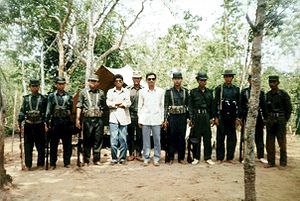The insurgency in the Chittagong Hill Tracts (Bengali: পার্বত্য চট্টগ্রামে বিদ্রোহ), also known as the Chittagong Hill Tracts conflict (Bengali: পার্বত্য চট্টগ্রাম যুদ্ধ), refers to a political and armed conflict that occurred in Bangladesh in two phases:
- First phase happened from 1977 to 1997 between the government of Bangladesh and the Parbatya Chattagram Jana Samhati Samiti (United People's Party of the Chittagong Hill Tracts) and its armed wing, the Shanti Bahini, over the issue of autonomy and the land rights of Jumma people, mainly for Chakma people and the other ethnic minority of Chittagong Hill Tracts. Shanti Bahini launched an insurgency against government forces in 1977, when the country was under military rule, and the conflict continued for twenty years until the government and the PCJSS signed the Chittagong Hill Tracts Peace Accord in 1997.[9][10][11]
- Second phase started in 2022 with the Kuki-Chin National Front under Nathan Bom, who wanted to establish a separate state for the Kuki-Chin ethnic groups in the Bandarban & Rangamati district, and still ongoing.
The actions then carried out by the Armed Forces and the Parbatya Chattagram Jana Sanghati Samiti groups resulted in casualties on both sides.[12] There were also reports of mass rapes by the paramilitary Bangladesh Ansars, though these have been disputed.[13] According to Amnesty International as of June 2013 the Bangladeshi government made "praiseworthy progress" in implementing the terms of the peace accord and in addressing the Jumma people's concerns over the return of their land. Amnesty estimate that there are currently only 900 internally displaced Jumma families.[14][15]
- ^ Dowlah, Caf (2013). "Jumma insurgency in Chittagong Hills Tracts: how serious is the threat to Bangladesh's national integration and what can be done?". Small Wars & Insurgencies. 24 (5): 775, 788–789. doi:10.1080/09592318.2013.866419. S2CID 144593890.
- ^ a b c Fortna, Virginia Page (2008). Does Peacekeeping Work?: Shaping Belligerents' Choices after Civil War. Princeton University Press. pp. 53–. ISBN 978-1-4008-3773-1.
- ^ a b c d Talukdar, S. P. (1988). The Chakmas, life and struggle. Delhi: Gian Pub. House. p. 52. ISBN 81-212-0212-4.
- ^ "Shanti Bahini | IPCS". www.ipcs.org. Retrieved 24 August 2024.
- ^ "Evolution of Kuki Chin National Front as Separatist Group and Impact on National and Region Security" (PDF). Bangladesh Institute Of Peace And Security Studies. 6 August 2019. Archived from the original (PDF) on 5 June 2024. Retrieved 8 August 2024.
- ^ "Bangladesh/Chakmas (1972-present)", University of Central Arkansas, archived from the original on 10 August 2024
- ^ a b The fragility of peace in the Chittagong Hill Tracts, Bangladesh
- ^ a b "Chronology for Chittagong Hill Tribes in Bangladesh", refworld.org, 2004, archived from the original on 18 November 2019
- ^
- Rashiduzzaman, M. (July 1998). "Bangladesh's Chittagong Hill Tracts Peace Accord: Institutional Features and Strategic Concerns". Asian Survey. 38 (7). University of California Press: 653–70. doi:10.2307/2645754. JSTOR 2645754.
- Harrison, Frances (2 December 1997). "Bangladesh peace treaty signed". BBC News. Archived from the original on 9 October 2023. Retrieved 11 June 2008.
- "Chittagong marks peace anniversary". BBC News. 2 December 1998. Archived from the original on 3 September 2024. Retrieved 11 June 2008.
- ^ Mohsin, Amena (2012). "Chittagong Hill Tracts Peace Accord, 1997". In Islam, Sirajul; Jamal, Ahmed A. (eds.). Banglapedia: National Encyclopedia of Bangladesh (Second ed.). Asiatic Society of Bangladesh. Archived from the original on 7 September 2024.
- ^ "Ministry of Chittagong Hill Tracts Affairs". Archived from the original on 8 July 2008.
- ^ Cite error: The named reference
Begovich 2007 p165was invoked but never defined (see the help page). - ^ Cite error: The named reference
Jonassohn 1998 p258was invoked but never defined (see the help page). - ^ Cite error: The named reference
Amnesty International 2013was invoked but never defined (see the help page). - ^ Cite error: The named reference
Erueti ABC 2013was invoked but never defined (see the help page).
